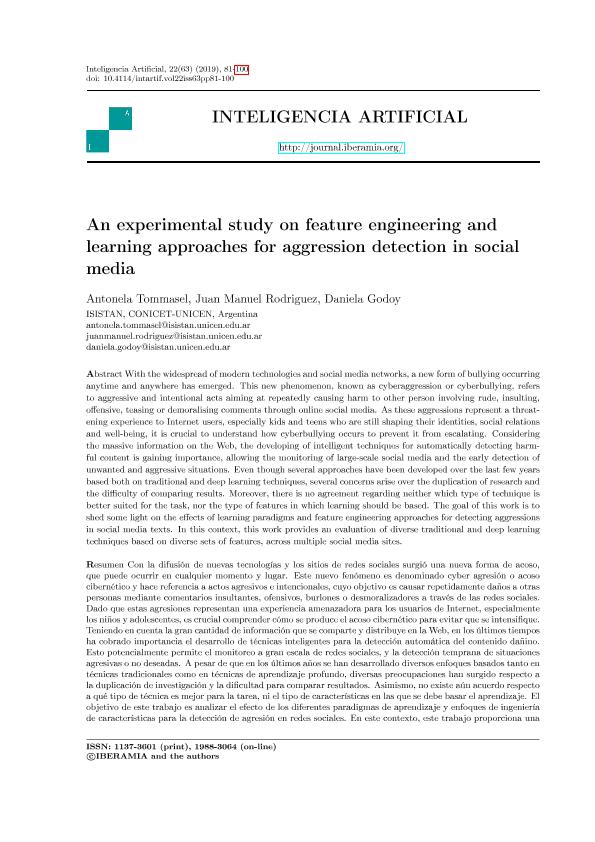Artículo
With the widespread of modern technologies and social media networks, a new form of bullying occurring anytime and anywhere has emerged. This new phenomenon, known as cyberaggression or cyberbullying, refers to aggressive and intentional acts aiming at repeatedly causing harm to other person involving rude, insulting, offensive, teasing or demoralising comments through online social media. As these aggressions represent a threatening experience to Internet users, especially kids and teens who are still shaping their identities, social relations and well-being, it is crucial to understand how cyberbullying occurs to prevent it from escalating. Considering the massive information on the Web, the developing of intelligent techniques for automatically detecting harmful content is gaining importance, allowing the monitoring of large-scale social media and the early detection of unwanted and aggressive situations. Even though several approaches have been developed over the last few years based both on traditional and deep learning techniques, several concerns arise over the duplication of research and the difficulty of comparing results. Moreover, there is no agreement regarding neither which type of technique is better suited for the task, nor the type of features in which learning should be based. The goal of this work is to shed some light on the effects of learning paradigms and feature engineering approaches for detecting aggressions in social media texts. In this context, this work provides an evaluation of diverse traditional and deep learning techniques based on diverse sets of features, across multiple social media sites. Con la difusión de nuevas tecnologías y los sitios de redes sociales surgió una nueva forma de acoso, que puede ocurrir en cualquier momento y lugar. Este nuevo fenómeno es denominado cyber agresión o acoso cibernético y hace referencia a actos agresivos e intencionales, cuyo objetivo es causar repetidamente daños a otras personas mediante comentarios insultantes, ofensivos, burlones o desmoralizadores a través de las redes sociales. Dado que estas agresiones representan una experiencia amenazadora para los usuarios de Internet, especialmente los niños y adolescentes, es crucial comprender cómo se produce el acoso cibernético para evitar que se intensifique. Teniendo en cuenta la gran cantidad de información que se comparte y distribuye en la Web, en los últimos tiempos ha cobrado importancia el desarrollo de técnicas inteligentes para la detección automática del contenido dañino. Esto potencialmente permite el monitoreo a gran escala de redes sociales, y la detección temprana de situaciones agresivas o no deseadas. A pesar de que en los últimos años se han desarrollado diversos enfoques basados tanto en técnicas tradicionales como en técnicas de aprendizaje profundo, diversas preocupaciones han surgido respecto a la duplicación de investigación y la dificultad para comparar resultados. Asimismo, no existe aún acuerdo respecto a qué tipo de técnica es mejor para la tarea, ni el tipo de características en las que se debe basar el aprendizaje. El objetivo de este trabajo es analizar el efecto de los diferentes paradigmas de aprendizaje y enfoques de ingeniería de características para la detección de agresión en redes sociales. En este contexto, este trabajo proporciona una evaluación en múltiples redes sociales de diversas técnicas tradicionales y de aprendizaje profundo, basadas en diversos conjuntos de características.
An experimental study on feature engineering and learning approaches for aggression detection in social media
Fecha de publicación:
02/2019
Editorial:
Sociedad Iberoamericana de Inteligencia Artificial
Revista:
Inteligencia Artificial
ISSN:
1137-3601
e-ISSN:
1988-3064
Idioma:
Inglés
Tipo de recurso:
Artículo publicado
Clasificación temática:
Resumen
Archivos asociados
Licencia
Identificadores
Colecciones
Articulos(ISISTAN)
Articulos de INSTITUTO SUPERIOR DE INGENIERIA DEL SOFTWARE
Articulos de INSTITUTO SUPERIOR DE INGENIERIA DEL SOFTWARE
Citación
Tommasel, Antonela; Rodriguez, Juan Manuel; Godoy, Daniela Lis; An experimental study on feature engineering and learning approaches for aggression detection in social media; Sociedad Iberoamericana de Inteligencia Artificial; Inteligencia Artificial; 22; 63; 2-2019; 81-100
Compartir
Altmétricas




